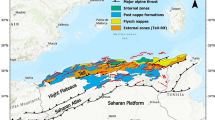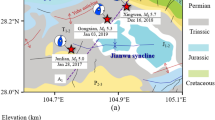Abstract
Mumbai city, the economical capital of India, is located on the west coast of stable intra-plate continental region of Peninsular India which has an experience of significant historical earthquakes in the past. The city stood as the fourth most populous city in the world. Recent seismo-tectonic studies of this city highlighted the presence of active West coast fault and Chiplun fault beneath the Deccan basalt. In the present study, spatial variability of probabilistic seismic hazard for Mumbai region (latitudes of 18.85–19.35°N and longitudes of 72.80–73.15°E at a grid spacing of 0.05°) which includes Mumbai city, Suburban, part of Thane district and Navi Mumbai, in terms of ground motion parameters; peak horizontal acceleration and spectral acceleration at 1.0-s period for 2 and 10 % probability of exceedance in 50 years are generated. The epistemic uncertainty in hazard estimation is accounted by employing seven different ground motion prediction equations developed for worldwide shallow crustal intra-plate environments. Further, the seismic hazard results are deaggregated for Mumbai (latitude 18.94°N, longitude 72.84°E) to understand the relative contributions of earthquake sources in terms of magnitude and distance. The generated hazard maps are compared with the zoning specified by Indian seismic code (IS1893: Part 1 in Indian standard criteria for earthquake-resistant design of structures, Part 1—General provisions and buildings. Bureau of Indian Standards, New Delhi, India, 2002) for rocky site. Present results show an underestimation of potential seismic hazard in the entire study region by non-probabilistic zoning prescribed by IS1893: Part 1 with significantly higher seismic hazard values in the southern part of Navi Mumbai.














Similar content being viewed by others
Abbreviations
- PHA:
-
Peak horizontal acceleration
- S a :
-
Spectral acceleration
- g :
-
Gravitational acceleration (9.81 m/s2)
- M w :
-
Earthquake moment magnitude
- UHRS:
-
Uniform hazard response spectrum
- λ Mw :
-
Mean annual rate of exceedance
- a, b :
-
Gutenberg–Richter earthquake recurrence parameters
- M 0 :
-
Threshold moment magnitude
- N (M 0):
-
Frequency of earthquake occurrence of M w ≥ M 0
- β :
-
A coefficient (=2.303b)
- N i (M 0):
-
Weighing function for ith fault
- M u :
-
Maximum potential earthquake magnitude assigned to fault
- α i :
-
Fault-weighing factor for length of ith fault
- x i :
-
Fault-weighting factor for number of earthquakes pertaining to ith fault
- DBE:
-
Design basis earthquake
- MCE:
-
Maximum considered earthquake
- A h :
-
Design horizontal seismic acceleration coefficient
References
Abrahamson NA, Silva WJ (1997) Empirical response spectral attenuation relations for shallow crustal earthquakes. Seismol Res Lett 68(1):94–127
Anbazhagan P, Sitharam TG, Vinod JS (2009a) Site classification and estimation of surface level seismic hazard using geophysical data and probabilistic approach. J Appl Geophys 68:219–230
Anbazhagan P, Vinod JS, Sitharam TG (2009b) Probabilistic seismic hazard analysis for Bangalore. Nat Hazards 48(2):145–166
Atkinson GM, Boore DM (1997) Some comparisons between recent ground motion relationships. Seismol Res Lett 68:24–40
Bonilla MG, Mark RK, Lienkaemper JJ (1984) Statistical relations among earthquake magnitude, surface rupture length and surface fault displacement. Bull Seismol Soc Am 74:2379–2411
Boominathan A, Dodagoudar GR, Suganthi A, Uma Maheswari R (2008) Seismic hazard assessment of Chennai city considering local site effects. J Earth Syst Sci 117(S2):853–863
Boore DM, Joyner WB, Fumal TE (1997) Equations from estimating horizontal response spectra and peak acceleration from Western North American earthquakes: a summary of recent work. Seismol Res Lett 68:128–153
Campbell KW (1997) Empirical near-source attenuation relationships for horizontal and vertical components of peak ground acceleration, peak ground velocity, and pseudo-absolute acceleration response spectra. Seismol Res Lett 68(1):154–179
Chandra U (1977) Earthquakes of peninsular India-A seismotectonic study. Bull Seism Soc Am 67:1387–1413
Chatterjee K, Choudhury D (2013) Variations in shear wave velocity and soil site class in Kolkata city using regression and sensitivity analysis. Nat Hazards (in press for publication, available online. doi:10.1007/s11069-013-0795-7)
Choudhury D, Mhaske SY (2010) Geospatial technology for study of response system—phase of earthquake disaster management of Mumbai city. Disaster Adv 3(4):23–29
Choudhury D, Shukla J (2011) Probability of occurrence and study of earthquake recurrence models for Gujarat state in India. Disaster Adv 4(2):47–59
Cornell CA (1968) Engineering seismic risk analysis. Bull Seismol Soc Am 58(5):1583–1606
Cramer CH, Kumar A (2003) 2001 Bhuj, India, earthquake engineering seismoscope recordings and eastern North America ground motion attenuation relations. Bull Seismol Soc Am 93:1390–1394
CRISIS (2007) Version 7.2 program for computing seismic hazard developed by Ordaz M, Aguilar A, Arboleda, Instituto de Ingenieria, UNAM, Mexico
Gangrade BK, Arora SK (2000) Seismicity of the Indian peninsular shield from regional earthquake data. Pure Appl Geophys 157:1683–1705
Gardner JK, Knopoff L (1974) Is the sequence of earthquakes in southern California, with aftershocks removed, Poissonian? Bull Seismol Soc Am 64(5):1363–1367
Guha SK, Basu PC (1993) Catalogue of earthquake (M > 3) in Peninsular India. Atomic energy regulatory board, Tech document no. TD/CES-1, 1–70
Gutenberg B, Richter CF (1944) Frequency of earthquakes in California. Bull Seismol Soc Am 34:185–188
Heaton TH, Tajima TF, Mori AW (1986) Estimating ground motions using recorded accelerograms. Surv Geophys 8:25–83
IS1893: Part 1 (2002) Indian standard criteria for earthquake resistant design of structures, Part 1 – General provisions and buildings. Bureau of Indian Standards, New Delhi, India
Iyengar RN, Ghosh S (2004) Microzonation of earthquake hazard in greater Delhi area. Curr Sci 87:1193–1202
Jaiswal K, Sinha R (2007a) Probabilistic seismic-hazard estimation for peninsular India. Bull Seismol Soc Am 97:318–330
Jaiswal K, Sinha R (2007b) Spatial variation of maximum considered and design basis earthquakes in peninsular India. Curr Sci 92(5):639–645
Kaila KL, Gaur VK, Hari N (1972) Quantitative seismicity maps of India. Bull Seismol Soc Am 62:1119–1131
Kolathayar S, Sitharam TG, Vipin KS (2012) Spatial variation of seismicity parameters across India and adjoining areas. Nat Hazards 60(3):1365–1379
Kramer SL (1996) Geotechnical earthquake engineering. Prentice-Hall international series in Civil Engineering and Engineering Mechanics, Prentice-Hall, New Jersey
Kumar P, Yuan X, Kumar MR, Kind R, Li X, Chadha RK (2007) The rapid drift of the Indian tectonic plate. Nature 449:894–897
Mark RK (1977) Application of linear statistical model of earthquake magnitude versus fault length in estimating maximum expectable earthquakes. Geology 5:464–466
Menon A, Ornthammarath T, Corigliano M, Lai CG (2010) Probabilistic seismic hazard macrozonation of Tamil Nadu in Southern India. Bull Seismol Soc Am 100(3):1320–1341
Mhaske SY, Choudhury D (2010) GIS-based soil liquefaction susceptibility map of Mumbai city for earthquake events. J Appl Geophysics 70(3):216–225
Mhaske SY, Choudhury D (2011) Geospatial contour mapping of shear wave velocity for Mumbai city. Nat Hazards 59(1):317–327
Nandy DR (1995) Neotectonism and seismic hazards in India. Indian J Geol 67:34–48
Nowroozi AA (1985) Empirical relations between magnitudes and fault parameters for earthquakes in Iran. Bull Seismol Soc Am 75:1327–1338
Nuttli OW (1979) Seismicity of the central United States, Geological Society of America. Rev Eng Geol 4:67–93
Phanikanth VS, Choudhury D, Reddy GR (2011) Equivalent-linear seismic ground response analysis of some typical sites in Mumbai. Geotech Geol Eng 29(6):1109–1126
Raghu Kanth STG, Iyengar RN (2006) Seismic hazard estimation for Mumbai city. Curr Sci 91(11):1486–1494
Raghu Kanth STG, Iyengar RN (2007) Estimation of seismic spectral acceleration in peninsular India. J Earth Syst Sci 3:199–214
Ram A, Rathor HS (1970) On frequency magnitude and energy of significant Indian earthquakes. Pure Appl Geophys 79:26–32
Ramalingeswara Rao B (2000) Historical seismicity and deformation rates in the Indian Peninsular Shield. J Seismol 4:247–258
Rao BR, Rao PS (1984) Historical seismicity of peninsular India. Bull Seismol Soc Am 74:2519–2533
Sadigh K, Chang CY, Egan JA, Makdisi F, Youngs RR (1997) Attenuation relations for shallow crustal earthquakes based on California strong motion data. Seismol Res Lett 68:180–189
Seeber L, Armbruster JG, Jacob KH (1999) Probabilistic assessment of seismic hazard for Maharashtra. Govt of Maharashtra, Unpublished
SEISAT (2000) Seismotectonic atlas of India, Geological Survey of India
Shukla J, Choudhury D (2012a) Estimation of seismic ground motions using deterministic approach for major cities of Gujarat. Nat Hazards Earth Syst Sci 12:2019–2037
Shukla J, Choudhury D (2012b) Seismic hazard and site-specific ground motion for typical ports of Gujarat. Nat Hazards 60(2):541–565
Sitharam TG, Anbazhagan P (2007) Seismic hazard analysis for the Bangalore region. Nat Hazards 40:261–278
Sitharam TG, Vipin KS (2011) Evaluation of spatial variation of peak ground acceleration and spectral acceleration for south India: Probabilistic approach. Nat Hazards 59(2):639–653
Sitharam TG, James N, Vipin KS, Ganesha Raj K (2012) A study on seismicity and seismic hazard for Karnataka state. J Earth Syst Sci 121(2):475–490
Slemmon DB (1989) Determination of earthquake size from surface faulting events. In: Proceedings of the international seminar on Seismic Zoning, China
Tinti S, Mulargia F (1985) Completeness analysis of a seismic catalog. Ann Geophys 3:407–414
Toro GR, Abrahamson NA, Schneider JF (1997) Model of strong ground motions from earthquakes in central and eastern North America: best estimates and uncertainties. Seismol Res Lett 68:41–58
USNRG (1997) Identification and characterization of seismic sources and determination of SSE ground motion. Regul Guide 1(165):1–45
Vipin KS, Anbazhagan P, Sitharam TG (2009) Estimation of peak ground acceleration and spectral acceleration for South India with local site effects: probabilistic approach. Nat Hazards Earth Syst Sci 9:865–878
Wells DL, Coppersmith KJ (1994) Updated empirical relationships among magnitude, rupture length, rupture area and surface displacement. Bull Seismol Soc Am 84:4–43
Working committee of experts, National Disaster Management Authority, (WCE-NDMA) Govt of India (2010) Technical report on development of probabilistic seismic hazard map of India
Author information
Authors and Affiliations
Corresponding author
Rights and permissions
About this article
Cite this article
Desai, S.S., Choudhury, D. Spatial variation of probabilistic seismic hazard for Mumbai and surrounding region. Nat Hazards 71, 1873–1898 (2014). https://doi.org/10.1007/s11069-013-0984-4
Received:
Accepted:
Published:
Issue Date:
DOI: https://doi.org/10.1007/s11069-013-0984-4




